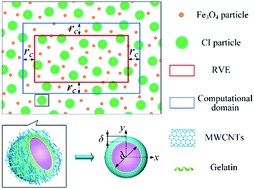Simulation of a bidisperse magnetorheological fluid using the combination of a two-component lattice Boltzmann method and a discrete element approach
Abstract
In this study, a two-component lattice Boltzmann method (TLBM) in combination with a discrete element approach (DEA) based on a representative volume element (RVE) with respect to a bidisperse magnetorheological fluid (MRF) was performed to simulate the behavior and microstructure formation of magnetic particles in a carrier liquid. The bidisperse MRF reported herein is a suspension dispersed by soft micron carbonyl iron (CI) particles and Fe3O4 nanoparticles dual-coated with gelatin and multi-walled carbon nanotubes (MWCNTs) in the carrier liquid. In the TLBM of two-component liquid and particle simulation, the inter-particle interactions were completely ignored; on the other hand, the DEA was just employed for calculating the dynamic behavior of particles. Therefore, due to the explicit nature of the combination of TLBM and DEA, it is a more efficient and accurate strategy for the simulation and calculation of complex MRF systems. Moreover, the immersed boundary method (IBM) was used to describe the interactions between the magnetic particles and the carrier liquid. The RVE of the bidisperse MRF was selected to eliminate specific operational conditions and reduce the calculation costs. New numerical results were obtained for the motion velocities, microstructure evolution and kinetic energy of bidisperse magnetic particles (BMPs) under the effect of a magnetic field; when the mass fraction of the nanoparticles was 0.1, the bidisperse MRF exhibited an improved response time in terms of the particle motion and microstructure formation. In addition, the effects of the Reynolds (Re) and Hartmann (Ha) numbers on the fluid–particle interaction and flow velocity were illustrated.



 Please wait while we load your content...
Please wait while we load your content...